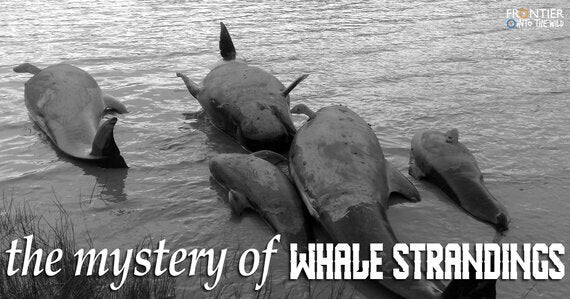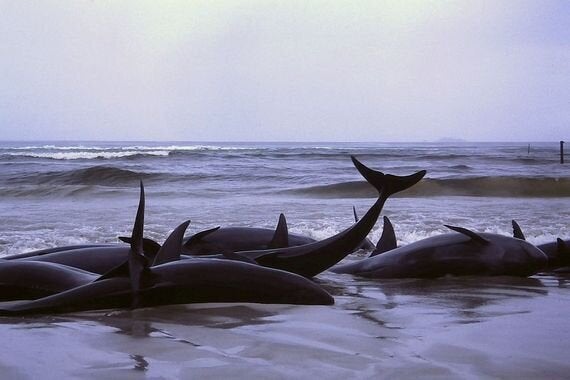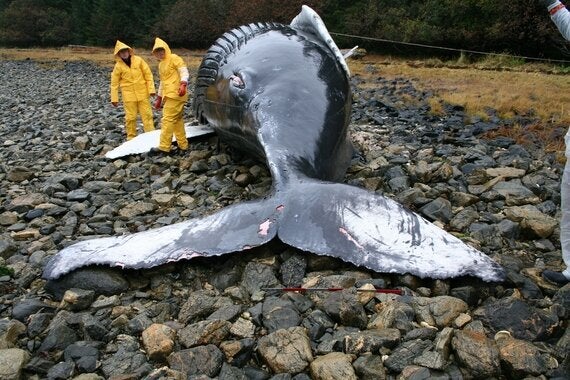
We know the images: colossal, glistening bodies, resting lifelessly on the shore, sometimes in the hundreds. Whale strandings are a sadly common occurrence often baffling local communities and scientists alike. So how do these majestic creatures end up stranded on shore, often en masse? The reason behind such tragedies remains a mystery... Whilst there is no universally agreed conclusion, several prevailing theories point towards some likely causes.
In February of this year, 407 pilot whales were discovered on New Zealand's South Island. In 2016, 29 sperm whales were found off the coasts of Germany, the Netherlands, England and northern France. This is by no means a modern occurrence - in Europe at least, records of mass whale strandings date back to 1577. The year 1918 saw the stranding of around 1000 pilot whales off the coast of the Chatham Islands, which remains the largest recorded stranding to date. Deeper-dwelling whale species make up the most fatalities, with long and short-finned pilot whales, false killer whales, melon headed whales and sperm whales being the most common casualties. These species all travel in water around 1000 metres deep and form large, cohesive groups that rely on strong social bonds with each other. The fact that they are deeper sea-dwelling creatures means that they can get into trouble when they find themselves in shallow areas with sloping seabeds.

Wikipedia Commons | Bahnfrend
There are several hypotheses regarding the causes of whale strandings, some pointing to human, and others to natural, causation. When hunting, for instance, their prey may lead them into dangerous territory. A whale's echolocation, used for navigation and hunting, will fail them once the waters become too shallow - pointing towards the fact that some strandings may simply be down to a navigational error. Another rationale may be the fact that already diseased whales may seek shallower waters in order to be able to surface more easily. While they may do this to conserve energy, remaining in such shallow waters will often contribute to internal bleeding caused by the compression of their chest walls against the hard surface of the shore.
The incredibly social nature of many whale species must also be taken into account when searching for reasons behind mass strandings. There have been several cases in which a significant portion of washed up whales seem to be healthy and rescuable, whilst the other half is not. Furthermore, there have been incidents during which one half of the group is simply there to vocally communicate and comfort the individuals in their group that are suffering. An incident in west Wales, for instance, when two dolphins became stranded alive, revealed that whilst one of the two was suffering from a severe parasite infection, the second dolphin was perfectly healthy yet showed signs of great distress and remained close to its companion. The strong social bonds that exist between the species may therefore mean that far from being some sort of mass suicide, en masse whale strandings may simply be an (albeit tragic) reflection of their incredible sociality.

Whilst whale strandings can seemingly be put down to a variety of natural causes, there is also reason to believe that some of them may be due to human activity. A particularly well-known example of this is the link between mass strandings and the use of sonar, the underwater echo navigation method often used during naval exercises. The connection was first made in 1996, when a NATO military exercise coincided with the stranding of 12 Cuvier's beaked whales. Similar occurrences followed in 2000 and 2002, with veterinary pathologists identifying acoustic trauma and haemorrhaging around the ear. Furthermore, they found some whales to be suffering from decompression sickness, indicating that naval sonar may interfere with a whale's ability to manage the gasses inside their body, hence making surfacing and diving very difficult. Whilst ultimately the absolute number of sonar-related strandings is small, it is the fact that strandings increased with the use of sonar that points towards the detrimental effects of this anthropogenic activity.
Recent studies are examining the hypothesis that strandings could also be caused by exhaustion as a result of human underwater activity. While of course these marine creatures do not get tired following their usual speed, unknown activity (such as sonar or seismic exploration) may force them to alternate movement patterns. Most whales pick up speed by repeating a cycle of short energy bursts and gliding, using this method to move rapidly when hunting prey, for instance. However, researchers are hypothesizing that human interferences are causing whales to ascend from their dives much more rapidly, switching to faster and more constant strokes which use up to 30% more energy than normal. This may explain not only the decompression sickness (which is often also experienced by scuba divers if they ascend too quickly) that has been documented, but also the increased likelihood of disorientation.
A definitive, singular reason behind strandings will probably never come to light. Instead, it is likely that such tragedies are simply caused by a multitude of both natural causes and anthropogenic interference. By continued study however, humans may be able to figure out the detrimental effects of our increased underwater activity - and work towards preventing such devastation.
By Laura Hallensleben - Online Journalism Intern
Frontier runs conservation, development, teaching and adventure travel projects in over 50 countries worldwide - so join us and explore the world!
